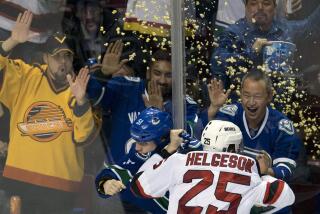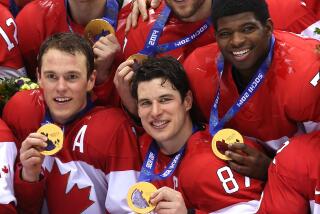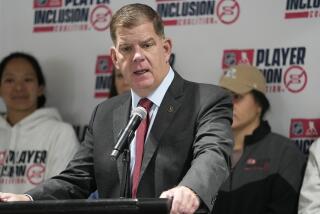Now Is Right Time for NHL to Make Changes On the Fly
- Share via
Some called the first couple of games in the Stanley Cup finals boring or dull -- or both. But by the time the Devils hoisted the Cup in victory, even skeptics had to admit the NHL had turned the corner and grabbed the attention of many new fans. Just look at ABC’s ratings, which were the highest for hockey since 1980.
“We’re not going to soon forget those two overtime games that ended the Stanley Cup finals,” Canucks General Manager Brian Burke says. “You couldn’t ask for much more excitement than that.”
The four-on-four overtime format was introduced in the 1999-2000 season, and it provided some of the most exciting hockey I’ve seen in years.
Still, there were issues: Marty McSorley’s slash of Donald Brashear, the increased numbers of concussions and serious injuries to Montreal’s Trent McCleary (throat), Toronto’s Bryan Berard (eye) and Philadelphia’s Eric Lindros (head).
But those problems haven’t forced the NHL’s hand. In fact, the opposite is true. The 2000-01 season begins October 5, but the only things new in the NHL are teams in Columbus and Minnesota and the use of the two-referee system for every game.
Here are five things that need to be fixed:
Ice isn’t always so nice: Hockey is a sport that needs to promote its stars, especially now that Mario Lemieux and Wayne Gretzky are retired. As a result, that promotion only can come on the ice. And the ice isn’t always great.
“They go out and spend $200 million to build these new arenas, so does it make sense that playing on good ice is the biggest problem in the game today?” Lindros asked at the All-Star Game in January. “Fans are paying more to see us show off our skills, but how can you when you can’t skate or pass your best? ... You have the great ice in Edmonton -- and then you have all the rest.”
Synthetic ice appears to be the only viable solution, but the reality of artificial ice with the same properties of real ice is at least a year away.
Offensive trends: Scoring increased just a tad last season. But something more is needed--and I don’t mean making the net bigger or forcing a goalie to stay in his crease all night.
“For scoring to improve, there has to be more flow to the game,” Stars coach Ken Hitchcock says. “There are still too many shortcuts to slowing down the game. It’s too easy to neutralize a star with the way the game is officiated now.” And maybe coaches need a lesson in Creative Offense 101, where there’s an emphasis on trying to win instead of playing not to lose.
Enforce the rules: Rules clearly need to be enforced, players need to be re-educated, and the NHL needs to make it happen.
“As much as I liked the two referees,” Blues GM Larry Pleau says, “I think it will be better this season. You won’t have two strangers working each game. You won’t have the older ref battling for power over a younger ref. I think you’ll see them working closer together this season. And I think the game will be better because of it.”
More double-digit suspensions like the ones to McSorley and New Jersey’s Scott Niedermayer must be made by V.P. Colin Campbell. And hiring Andy vanHellemond, 14 times voted the league’s best referee, to supervise officiating is intended to help avoid more public-relations messes.
More than hurt feelings: The injury situation is not going to get better soon. Players are bigger, stronger and faster, and the ice surfaces are still the same size. Plus, improved equipment in some cases has been turned into weaponry (elbow pads). And in trying to compress the schedule the NHL has created more three-games-in-four-nights situations and more serious injuries because there just isn’t enough time for proper rehabilitation.
Expanding horizons? It’s nice to get an $80 million cash-flow injection with each expansion team. But adding Columbus and Minnesota make it four expansion teams in the last three years and nine since the 1990-91 season. That’s too many.
Last season we had what I consider the best group of young players in the NHL since I began covering the league in 1969. But the quality of play overall is watered down. Instead of seeing more scoring--like home runs partially traceable to baseball’s watered-down pitching--you see more coaches falling back on the dreaded neutral-zone trap, which they can use to compete right away.
Coming off a season in which there were no 100-point players and only one player scored more than 44 goals, that’s not progress, is it?
More to Read
Go beyond the scoreboard
Get the latest on L.A.'s teams in the daily Sports Report newsletter.
You may occasionally receive promotional content from the Los Angeles Times.






